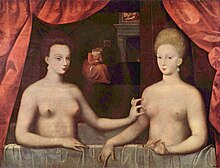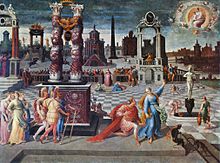Fontainebleau School
Fontainebleau School is the name for a group of artists and for the variety of Mannerism they shaped , which originated from Fontainebleau Castle , the preferred residence of the French King Francis I , from the 16th to the beginning of the 17th century .
The king's patronage, which extended to literature and science as well as art, made Fontainebleau a center for the dissemination of Renaissance ideas and the art of Mannerism in northern Europe.
A distinction is made between two different epochs, separated by a period of about fifteen years. The artists in the first phase all came from Italy. They are grouped under the name Fontainebleau First School . The artists of the Second School of Fontainebleau , who remained active until the early 17th century, usually came from France or Flanders.
First School of Fontainebleau, 1530-1570
When France invaded Italy between 1494 and 1499, through the works of art, book art, literature and science, Francis I had knowledge of the flourishing of Italian culture. After his accession to the throne, he endeavored to underline his claim to power in Europe with a splendid residence comparable to the courts in Florence , Mantua or Milan . In addition to humanistic scholars, he invited renowned Italian painters and architects to France, alongside the old Leonardo also Michelangelo , who, however, did not respond to the call to France, the architects Vignola and Serlio or the goldsmith Cellini , who made his famous Saliera for the king in Fontainebleau . However, these artists stayed only briefly in France without leaving any lasting traces.
However, the arrival of Rosso Fiorentino in 1531 , who was to stay in Fontainebleau until his death in 1540 , had consequences. In 1532 he was followed by Primaticcio , who, apart from brief trips to Italy, also never left France on behalf of the king. The third of this group, known as the First School of Fontainebleau , was Nicolò dell'Abbate from Bologna in 1552 , whom Henry II had engaged at the request of Primaticcio.
The main task of these artists was the glamorous furnishing of Fontainebleau with pictures, frescoes, sculptures, reliefs, stucco work, leather wallpapers and tapestries. Rosso's main work is the Galerie François Ier , which is still in good condition today , the first of its kind in France, which was designed between 1531 and 1540. After Rosso's death, Primaticcio continued the work in Fontainebleau. However, the king's bedroom furnished by him has been completely destroyed; only fragments of the Duchess d'Estampes' drawing room have survived. His colleague and later successor Niccolo dell'Abbate furnished the ballroom and the Ulysses gallery , which were demolished in 1697. The interior of the destroyed rooms can, however, be reconstructed by means of numerous preserved carpets in which the images of the rooms were copied.
Because of the wars of religion from 1584 to 1595 and the question of succession after the death of the last Valois Henri III. the work was interrupted because the castle had been abandoned.
Second school of Fontainebleau, 1590 to 1620
During the reign of Henri IV , the castle was extensively restored. The king invited Flemish and French artists to Fontainebleau, called the Second School of Fontainebleau as an artist group. These include Ambroise Dubois from Antwerp and the Parisians Toussaint Dubreil , Antoine Caron and Martin Fréminet as well as a number of anonymous artists who are usually referred to by emergency names. Dubreuil painted the Pavillon des Poésies, which was destroyed in 1703. The furnishings for the Trinity Chapel in Fontainebleau were made by Fréminet between 1606 and 1616 and have been preserved to this day.
From the second phase of the Fontainebleau school comes a series of erotic images, for which there was obviously a particular preference. An example of this type of painting, with its iconography , which has not yet been fully deciphered, is the picture by an anonymous painter Gabrielle d'Estrées with her sister, the Duchess of Villars , which is shown in the Louvre today.
Typical for Fontainebleau is the general renunciation of religious painting, the preference for themes from Greek and Roman mythology or erotic subjects, a preference for ornaments and grotesques , for the integration of painting, sculpture and stucco in an overall concept as well as with the figures a tendency to elongate the figures similar to that of the mannerist painters of Italy. The special thing about the erotic images is an overemphasized, refined eroticism with simultaneous distant brittleness and a lack of emotionality and sensuality. In the iconography of the paintings one loves puzzles, codes and scholarly allusions and in the execution one prefers long-limbed, capricious figures in clear contours, while the color effect of the pictures often remains cool and of subdued expressiveness.
aftermath
The style developed at Fontainebleau quickly spread throughout France and northern Europe, while influences in Italy remained marginal. Knowledge of sculptures from Fontainebleau was spread through replicas made of bronze and clay. The most important media of this transfer, however, were above all the tapestries, which were woven in the Fontainebleau factory, as well as the copperplate engravings, of which there was a flourishing production. From René Boyvin , for example, who documented Rosso's work in Fontainebleau in engravings, 240 sheets have survived that are ascribed to him. Another artist who disseminated the school's works through his engravings was Gian Giacomo Caraglio .
Boyvin ran a flourishing workshop with Pierre Millan, which after the death of Francis I relocated to Paris. Other engravers working in Fontainebleau are Antonio Fantuzzi, also from Bologna, as well as Primaticcio and his close collaborators, the Italians Francesco Penni and his son Luca, the French Léon Davent, Jean Mignon, Geoffroy Dumoustier, and Domenico del Barbiere, another Italian.
Examples
- Nicolò dell'Abbate : Orpheus and Eurydice, National Gallery , London
- Antoine Caron : Augustus and the Sibyl of Tibur, around 1580, Louvre , Paris
- Antoine Caron : Funeral of Cupid, Louvre, Paris illustration
- François Clouet : Lady in the Bath, National Gallery of Art , Washington
- Jean cousin : Eva prima Pandora, around 1538, Louvre , Paris
- The Nymph of Fontainebleau, engraving by Pierre Milan and René Boyvin after Rosso Fiorentino, illustration around 1545
- Master of the Flora: Birth of Cupid, around 1560/65? Metropolitan Museum of Art , New York
- Unknown master: The woman between the two ages, around 1580, Rennes , Musée des Beaux-Arts
- Unknown master: Gabriele d'Estrées and her sister, Louvre , Paris
- Toussaint Dubreuil : Hyacinthe and Climène at the morning toilet, 1602, Louvre, Paris
literature
- Sylvie Béguin: L'école de Fontainebleau . Edition des musées nationaux, Paris 1972 (exhibition catalog)
- Jean-Jacques Lévêque: L'école de Fontainebleau . Edition Ides & Calendes, Neuchâtel 1984, ISBN 2-8258-0012-0 .
- André Pieyre de Mandiargues: L'école de Fontainebleau . Imp. Reunies, Lausanne 1963 (exhibition catalog).
- Henri Zerner: The School of Fontainebleau. The graphic work ("L'école de Fontainebleau"). Schroll publishing house, Vienna 1969.
Barbizon School
A group of 19th century artists around the painter Théodore Rousseau , who worked temporarily in the village of Barbizon near Fontainebleau , is called the Barbizon School .



